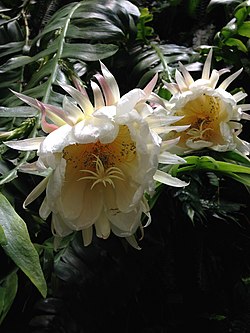| Epiphyllum chrysocardium | |
|---|---|
 | |
| Scientific classification | |
| Kingdom: | Plantae |
| Clade: | Tracheophytes |
| Clade: | Angiosperms |
| Clade: | Eudicots |
| Order: | Caryophyllales |
| Family: | Cactaceae |
| Subfamily: | Cactoideae |
| Genus: | Epiphyllum |
| Species: | E. chrysocardium |
| Binomial name | |
| Epiphyllum chrysocardium Alexander | |
 | |
| Epiphyllum chrysocardium is native to Southeast Mexico [3] | |
| Synonyms [3] | |
| |
Epiphyllum chrysocardium (syn. Selenicereus chrysocardium) is an epiphytic cactus [4] endemic to Mexico. [3] It is sometimes called fern leaf cactus, or golden heart epiphyllum.
